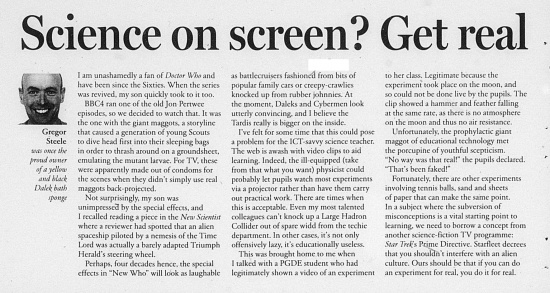Science on screen? Get real
- Publication: Times Educational Supplement
- Date: 2010-02-05
- Author: Gregor Steele
- Page: 23
- Language: English
I am unashamedly a fan of Doctor Who and have been since the Sixties. When the series was revived, my son quickly took to it too.
BBC4 ran one of the old Jon Pertwee episodes, so we decided to watch that. It was the one with the giant maggots, a storyline that caused a generation of young Scouts to dive head first into their sleeping bags in order to thrash around on a groundsheet, emulating the mutant larvae. For TV, these were apparently made out of condoms for the scenes when they didn't simply use real maggots back-projected.
Not surprisingly, my son was unimpressed by the special effects, and I recalled reading a piece in the New Scientist where a reviewer had spotted that an alien spaceship piloted by a nemesis of the Time Lord was actually a barely adapted Triumph Herald's steering wheel.
Perhaps, four decades hence, the special effects in "New Who" will look as laughable as battlecruisers fashioned from bits of popular family cars or creepy-crawlies knocked up from rubber johnnies. At the moment, Daleks and Cybermen look utterly convincing, and I believe the Tardis really is bigger on the inside.
I've felt for some time that this could pose a problem for the ICT-savvy science teacher. The web is awash with video clips to aid learning. Indeed, the ill-equipped (take from that what you want) physicist could probably let pupils watch most experiments via a projector rather than have them carry out practical work. There are times when this is acceptable. Even my most talented colleagues can't knock up a Large Hadron Collider out of spare widd from the techie department. In other cases, it's not only offensively lazy, it's educationally useless.
This was brought home to me when I talked with a PGDE student who had legitimately shown a video of an experiment to her class. Legitimate because the experiment took place on the moon, and so could not be done live by the pupils. The clip showed a hammer and feather falling at the same rate, as there is no atmosphere on the moon and thus no air resistance.
Unfortunately, the prophylactic giant maggot of educational technology met the porcupine of youthful scepticism. "No way was that real!" the pupils declared. "That's been faked!"
Fortunately, there are other experiments involving tennis balls, sand and sheets of paper that can make the same point. In a subject where the subversion of misconceptions is a vital starting point to learning, we need to borrow a concept from another science-fiction TV programme: Star Trek's Prime Directive. Starfleet decrees that you shouldn't interfere with an alien culture. Ours should be that if you can do an experiment for real, you do it for real.
Gregor Steele was once the proud owner of a yellow and black Dalek bath sponge.
Disclaimer: These citations are created on-the-fly using primitive parsing techniques. You should double-check all citations. Send feedback to whovian@cuttingsarchive.org
- APA 6th ed.: Steele, Gregor (2010-02-05). Science on screen? Get real. Times Educational Supplement p. 23.
- MLA 7th ed.: Steele, Gregor. "Science on screen? Get real." Times Educational Supplement [add city] 2010-02-05, 23. Print.
- Chicago 15th ed.: Steele, Gregor. "Science on screen? Get real." Times Educational Supplement, edition, sec., 2010-02-05
- Turabian: Steele, Gregor. "Science on screen? Get real." Times Educational Supplement, 2010-02-05, section, 23 edition.
- Wikipedia (this article): <ref>{{cite news| title=Science on screen? Get real | url=http://cuttingsarchive.org/index.php/Science_on_screen%3F_Get_real | work=Times Educational Supplement | pages=23 | date=2010-02-05 | via=Doctor Who Cuttings Archive | accessdate=20 June 2025 }}</ref>
- Wikipedia (this page): <ref>{{cite web | title=Science on screen? Get real | url=http://cuttingsarchive.org/index.php/Science_on_screen%3F_Get_real | work=Doctor Who Cuttings Archive | accessdate=20 June 2025}}</ref>
